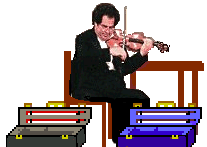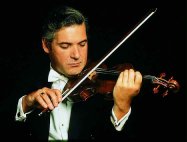MASTER CLASSES 
 Pinchas Zukerman masterclass. Sydney, Australia. August 31, 2000: - Renowned violinist/violist Pinchas Zukerman, visiting Australia as part
of the 2000 Olympics Arts Festival, presented masterclasses in three
cities. Students from around the country auditioned by tape for the
chance to participate and four were chosen to perform at each class.
In Sydney, the students were all violinists; most were prize winners of
local and international competitions with impressive resumes and all
were about 18 years old and currently undertaking tertiary training. Of
course, violin and viola students and teachers came from near and far to
watch, learn and take the rare opportunity to ask questions of the
master. Pinchas Zukerman masterclass. Sydney, Australia. August 31, 2000: - Renowned violinist/violist Pinchas Zukerman, visiting Australia as part
of the 2000 Olympics Arts Festival, presented masterclasses in three
cities. Students from around the country auditioned by tape for the
chance to participate and four were chosen to perform at each class.
In Sydney, the students were all violinists; most were prize winners of
local and international competitions with impressive resumes and all
were about 18 years old and currently undertaking tertiary training. Of
course, violin and viola students and teachers came from near and far to
watch, learn and take the rare opportunity to ask questions of the
master.
 Violinist, violist and conductor Pinchas Zukerman was born in Tel Aviv in
1948. He began his musical studies with his father, first on recorder and
clarinet and later on the violin. At 8, he entered the Israel Conservatory
and Academy of Music, studying with Ilona Feher and in 1961, with support
from cellist Pablo Casals, went to the United States to work with renowned
pedagogue Ivan Galamian at the Julliard School. Zukerman won the prestigious
Leventritt Foundation International Competition in 1967, which launched his
stellar career as one of the world's finest violinists. He is also well-known
as a chamber musician, performing on both violin and viola with colleages
including Itzhak Perlman, Isaac Stern, Daniel Barenboim, Vladimir Ashkenazy,
the Tokyo String Quartet and the late Jacqueline Du Pre. As a conductor, he
has worked regularly with the St Paul Chamber Orchestra, the Dallas Symphony
Orchestra and the English Chamber Orchestra. In 1998, he was appointed as
musical director of the National Arts Orchestra of Canada. Zukerman, who
records exclusively for BMG Classics/RCA Victor, has an extensive discography
which has earned him 21 Grammy nominations and two awards. Biography written by © Lee Anthony Violinist, violist and conductor Pinchas Zukerman was born in Tel Aviv in
1948. He began his musical studies with his father, first on recorder and
clarinet and later on the violin. At 8, he entered the Israel Conservatory
and Academy of Music, studying with Ilona Feher and in 1961, with support
from cellist Pablo Casals, went to the United States to work with renowned
pedagogue Ivan Galamian at the Julliard School. Zukerman won the prestigious
Leventritt Foundation International Competition in 1967, which launched his
stellar career as one of the world's finest violinists. He is also well-known
as a chamber musician, performing on both violin and viola with colleages
including Itzhak Perlman, Isaac Stern, Daniel Barenboim, Vladimir Ashkenazy,
the Tokyo String Quartet and the late Jacqueline Du Pre. As a conductor, he
has worked regularly with the St Paul Chamber Orchestra, the Dallas Symphony
Orchestra and the English Chamber Orchestra. In 1998, he was appointed as
musical director of the National Arts Orchestra of Canada. Zukerman, who
records exclusively for BMG Classics/RCA Victor, has an extensive discography
which has earned him 21 Grammy nominations and two awards. Biography written by © Lee Anthony
 Suggested Etiquette Suggested Etiquette
|


 Violin
Violin sheilascorner Home
sheilascorner Home Photography
Photography Websites
Websites Contributed and written by ©
Contributed and written by © 